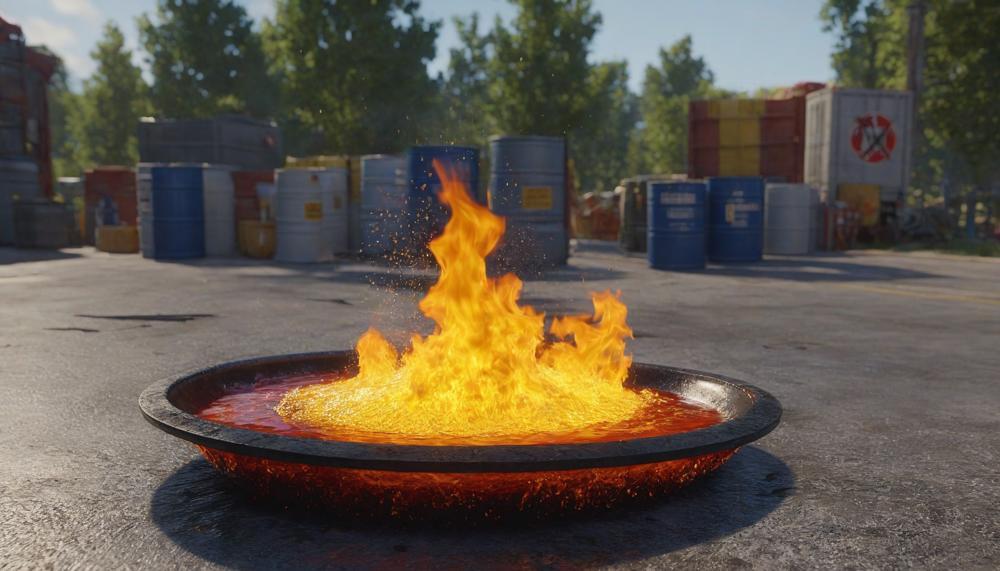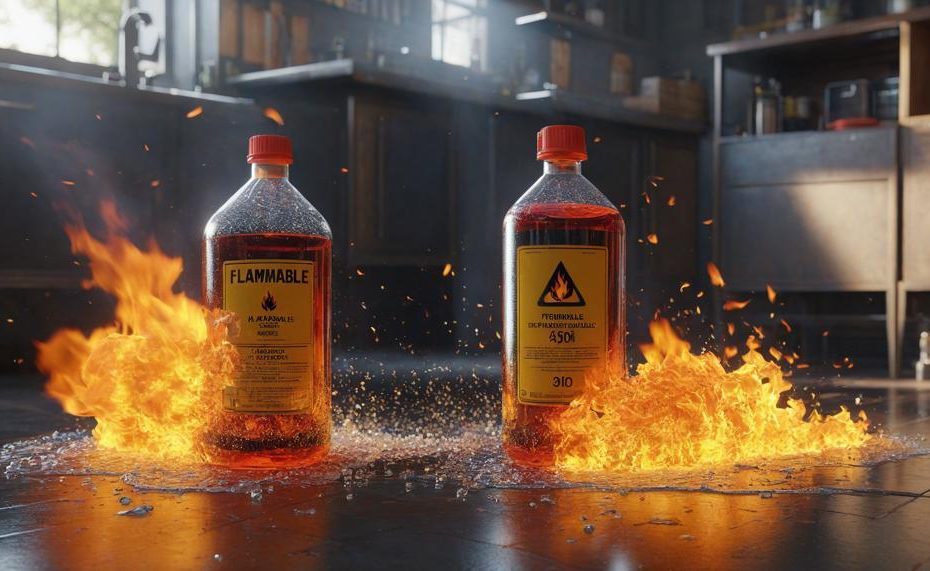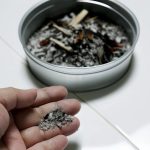Flammable liquids, from household cleaners to fuels, are a common part of our daily lives, but their disposal is anything but ordinary. Getting rid of these potentially dangerous substances safely and responsibly is vital to prevent fires, environmental damage, and health risks. Here’s how you can do it properly, ensuring safety for yourself and those around you:
Key Takeaways:
- Read Product Labels: Always start by checking the label for specific disposal instructions.
- Use Proper Containers: Store and transport flammable liquids in their original containers or in ones designed for such materials.
- Avoid Mixing: Never mix flammable liquids with other chemicals, as this can cause dangerous reactions.
- Utilize Disposal Facilities: Take flammable liquids to designated disposal sites or hazardous waste collection events.
Flammable liquids pose serious risks if not handled correctly, but with the right approach, you can safely dispose of them. This guide will walk you through the essential steps to ensure that these hazardous materials are dealt with in a manner that protects both people and the planet. Stay safe, stay informed, and let’s handle these materials with the care they deserve.
Contents
- 1 What are some safe and proper ways to dispose of flammable liquids found in households?
- 1.1 Understand the Substance:
- 1.2 Proper Storage:
- 1.3 Never Pour Down Drains:
- 1.4 Solidify Before Disposal:
- 1.5 Dispose of Solidified Waste Correctly:
- 1.6 Special Handling for Soaked Rags:
- 1.7 Seek Guidance from Local Authorities:
- 1.8 Transporting Flammable Liquids:
- 1.9 Environmental and Safety Laws:
- 1.10 Monitor Storage Areas:
- 2 How can you safely and effectively dispose of flammable liquids in your home to reduce hazardous household waste?
- 3 Regulating HHW
What are some safe and proper ways to dispose of flammable liquids found in households?
Handling and disposing of flammable liquids in your home requires meticulous attention to safety. Here are some safe and proper methods to follow:
Understand the Substance:
Always read the product labels for specific disposal instructions. Labels provide critical safety information.
Proper Storage:
Store flammable liquids in original containers or properly labelled, tightly sealed containers. Use dedicated storage cabinets away from other household items.
Never Pour Down Drains:
Pouring flammable liquids down sinks or drains can cause serious environmental harm and plumbing issues.
Solidify Before Disposal:
Small amounts can be solidified using sawdust or shredded newspaper. For larger volumes, use cat litter or oil dry. Conduct this process outdoors with proper safety gear.
Dispose of Solidified Waste Correctly:
Once solidified, the waste can be disposed of in regular trash. Work in manageable batches if needed.
Special Handling for Soaked Rags:
Store rags soaked with flammable liquids in a tightly sealed metal container and dispose of them immediately after use to prevent spontaneous combustion.
Seek Guidance from Local Authorities:
Contact your local waste management or environmental protection agency for specific disposal locations and regulations.
Transporting Flammable Liquids:
If required to transport these liquids to a disposal facility, follow the instructions on the label to ensure safe transportation.
Environmental and Safety Laws:
Adhere to relevant environmental laws to prevent legal issues and environmental damage.
Monitor Storage Areas:
Keep a close watch on storage areas, ensuring only authorized personnel have access.
How can you safely and effectively dispose of flammable liquids in your home to reduce hazardous household waste?
The short answer is to dispose of flammable liquids safely and effectively by following these guidelines:

| Step | Action | Details |
| 1 | Understand Handling | Familiarize yourself with the risks associated with flammable liquids by reading product labels and safety data sheets. |
| 2 | Avoid Drains and Burning | Never pour flammable liquids down drains or burn them. This can cause fires, explosions, and environmental harm. |
| 3 | Proper Storage | Store flammable liquids in a dedicated, clearly marked cabinet away from other household items. |
| 4 | Consult Authorities | Contact local environmental officials to ensure compliance with laws and guidelines for disposing of hazardous waste. |
| 5 | Solidification Method | Mix liquids with absorbent materials like sawdust, cat litter, or shredded newspaper to solidify them before disposal. |
| 6 | Manageable Batches | Dispose of the solidified material in your regular trash in small, manageable batches to avoid overloading the system. |
| 7 | Safe Rag Disposal | Keep rags soaked with flammable liquids in tightly sealed metal containers and dispose of them properly to prevent spontaneous combustion. |
| 8 | Partner with Waste Management | Consider working with a reputable waste management company for guidance and assistance in disposing of hazardous materials. |
Regulating HHW
The regulations for disposing of flammable liquids and other household hazardous waste (HHW) are extensive, aiming to protect human health and the environment. These rules vary across federal, state, and local levels, creating a comprehensive framework for managing these potentially dangerous materials.
Federal Regulations
At the federal level, the Environmental Protection Agency (EPA) sets guidelines for the disposal of HHW under the Resource Conservation and Recovery Act (RCRA). Although household hazardous waste is excluded from federal regulation under Subtitle C of RCRA, it is managed as solid waste under Subtitle D. This means the responsibility often falls to state and local governments to enforce regulations and provide proper disposal methods.
State and Local Regulations
State and local governments have more specific regulations and programs in place:
| State Regulations | Local Programs | Proper Disposal Methods |
| States have their own environmental protection agencies that implement additional rules for HHW disposal, often more stringent than federal guidelines. | Many communities have established HHW collection events or permanent collection centers where residents can safely dispose of hazardous materials. | Disposal methods include taking HHW to designated collection sites, participating in community collection events, or utilizing mail-back programs for certain items. |
| Examples include specific bans on disposing of HHW in regular trash and requirements for HHW to be taken to specialized facilities. | Local programs may provide curbside pickup services for certain hazardous wastes or special drop-off days. | Some areas offer recycling programs for specific HHW like batteries, electronics, and paints. |





